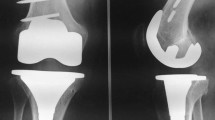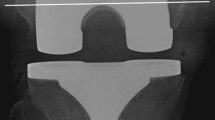Abstract
Purpose
Navigation has been introduced to achieve more accurate positioning of the implants after TKA. The scientific attention was mainly paid on limb alignment rather than restoration of the natural joint line. The aim of our study was to compare the accuracy of the joint line restoration in primary TKA with and without navigation. We hypothesized that joint line reconstruction in navigated TKA is more accurate.
Methods
A total of 493 primary TKAs operated in a single medical centre were consecutively selected and divided into two groups. 206 cases were performed computer assisted (BrainLab CI-System), whereas 287 knees were implanted conventionally. For both groups, the joint line position of the knee was determined on standardized calibrated standing pre- and postoperative digital radiographs in ap view by a modified method of Kawamura et al. A joint line shift of more than 8 mm was defined as outlier.
Results
In the conventional group, the joint line shift averaged 0.7 mm (±4.4 mm), whereas the findings in the computer-assisted cases were in average 0.6 mm (±4.5 mm). The joint line was located above 8 mm in 6 % of non-navigated versus 6.8 % of navigated primary TKAs. There were no statistically significant differences of joint line shift between the different component types. A statistically significant relation was not found between joint line shift and leg alignment changes.
Conclusions
Conventional surgical technique allows a precise joint line reconstruction in primary TKA. Navigation did not improve the joint line reconstruction.
Level of evidence
Diagnostic study, Level III.



Similar content being viewed by others
Notes
Platform: Ci Navigation Station Software: 2004–2005: Ci Knee 1.1.1 Producer: BrainLAB, Kapellenstr. 12, 2005–2011: Ci Knee 1.1.2 85622 Feldkirchen, Germany.
DePuy Orthopaedics, Inc, 700 Orthopaedic Derive, Warsaw.
Siemens AG, Henkestr. 127, D-91052 Erlangen, Germany.
References
Anderson KC, Buehler KC, Markel DC (2005) Computer assisted navigation in total knee arthroplasty: comparison with conventional methods. J Arthroplasty 20(3):132–138
Babazadeh S, Dowsey MM, Swan JD, Stoney JD, Choong PF (2011) Joint line position correlates with function after primary total knee replacement: a randomised controlled trial comparing conventional and computer-assisted surgery. J Bone Joint Surg Br 93(9):1223–1231
Bathis H, Perlick L, Tingart M, Luring C, Zurakowski D, Grifka J (2004) Alignment in total knee arthroplasty. A comparison of computer-assisted surgery with the conventional technique. J Bone Joint Surg Br 86(5):682–687
Belvedere C, Ensini A, Leardini A, Bianchi L, Catani F, Giannini S (2007) Alignment of resection planes in total knee replacement obtained with the conventional technique, as assessed by a modern computer-based navigation system. Int J Med Robot 3(2):117–124
Catani F, Biasca N, Ensini A, Leardini A, Bianchi L, Digennaro V, Giannini S (2008) Alignment deviation between bone resection and final implant positioning in computer-navigated total knee arthroplasty. J Bone Joint Surg Am 90(4):765–771
Chao EY, Neluheni EV, Hsu RW, Paley D (1994) Biomechanics of malalignment. Orthop Clin North Am 25(3):379–386
Chauhan SK, Clark GW, Lloyd S, Scott RG, Breidahl W, Sikorski JM (2004) Computer-assisted total knee replacement. A controlled cadaver study using a multi-parameter quantitative CT assessment of alignment (the Perth CT Protocol). J Bone Joint Surg Br 86(6):818–823
Cheng T, Zhao S, Peng X, Zhang X (2012) Does computer-assisted surgery improve postoperative leg alignment and implant positioning following total knee arthroplasty? A meta-analysis of randomized controlled trials? Knee Surg Sports Traumatol Arthrosc 20(7):1307–1322
Chin PL, Yang KY, Yeo SJ, Lo NN (2005) Randomized control trial comparing radiographic total knee arthroplasty implant placement using computer navigation versus conventional technique. J Arthroplasty 20(5):618–626
Chiu KY, Ng TP, Tang WM, Yau WP (2002) Review article: knee flexion after total knee arthroplasty. J Orthop Surg (Hong Kong) 10(2):194–202
Cope MR, O’Brien BS, Nanu AM (2002) The influence of the posterior cruciate ligament in the maintenance of joint line in primary total knee arthroplasty: a radiologic study. J Arthroplasty 17(2):206–208
Daubresse F, Vajeu C, Loquet J (2005) Total knee arthroplasty with conventional or navigated technique: comparison of the learning curves in a community hospital. Acta Orthop Belg 71(6):710–713
Decking R, Markmann Y, Fuchs J, Puhl W, Scharf HP (2005) Leg axis after computer-navigated total knee arthroplasty: a prospective randomized trial comparing computer-navigated and manual implantation. J Arthroplasty 20(3):282–288
Ensini A, Catani F, Biasca N, Belvedere C, Giannini S, Leardini A (2012) Joint line is well restored when navigation surgery is performed for total knee arthroplasty. Knee Surg Sports Traumatol Arthrosc 20(3):495–502
Fickert S, Jawhar A, Sunil P, Scharf HP (2012) Precision of Ci-navigated extension and flexion gap balancing in total knee arthroplasty and analysis of potential predictive variables. Arch Orthop Trauma Surg 132(4):565–574
Figgie HE III, Goldberg VM, Heiple KG, Moller HS III, Gordon NH (1986) The influence of tibial-patellofemoral location on function of the knee in patients with the posterior stabilized condylar knee prosthesis. J Bone Joint Surg Am 68(7):1035–1040
Grelsamer RP (2002) Patella baja after total knee arthroplasty: is it really patella baja? J Arthroplasty 17(1):66–69
Haaker RG, Stockheim M, Kamp M, Proff G, Breitenfelder J, Ottersbach A (2005) Computer-assisted navigation increases precision of component placement in total knee arthroplasty. Clin Orthop Relat Res 433:152–159
Hart R, Janecek M, Chaker A, Bucek P (2003) Total knee arthroplasty implanted with and without kinematic navigation. Int Orthop 27(6):366–369
Jenny JY, Boeri C (2001) Computer-assisted implantation of a total knee arthroplasty: a case-controlled study in comparison with classical instrumentation. Rev Chir Orthop Reparatrice Appar Mot 87(7):645–652
Jenny JY, Clemens U, Kohler S, Kiefer H, Konermann W, Miehlke RK (2005) Consistency of implantation of a total knee arthroplasty with a non-image-based navigation system: a case-control study of 235 cases compared with 235 conventionally implanted prostheses. J Arthroplasty 20(7):832–839
Jung YB, Lee HJ, Jung HJ, Song KS, Lee JS, Yang JJ (2009) Comparison of the radiological results between fluoroscopy-assisted and navigation-guided total knee arthroplasty. Knee Surg Sports Traumatol Arthrosc 17(3):286–292
Kawamura H, Bourne RB (2001) Factors affecting range of flexion after total knee arthroplasty. J Orthop Sci 6(3):248–252
Konig C, Sharenkov A, Matziolis G, Taylor WR, Perka C, Duda GN, Heller MO (2010) Joint line elevation in revision TKA leads to increased patellofemoral contact forces. J Orthop Res 28(1):1–5
Lee HJ, Lee JS, Jung HJ, Song KS, Yang JJ, Park CW (2011) Comparison of joint line position changes after primary bilateral total knee arthroplasty performed using the navigation-assisted measured gap resection or gap balancing techniques. Knee Surg Sports Traumatol Arthrosc 19(12):2027–2032
Martin JW, Whiteside LA (1990) The influence of joint line-position on knee stability after condylar knee arthroplasty. Clin Orthop Relat Res 259:146–156
Mullaji A, Kanna R, Marawar S, Kohli A, Sharma A (2007) Comparison of limb and component alignment using computer-assisted navigation versus image intensifier-guided conventional total knee arthroplasty: a prospective, randomized, single-surgeon study of 467 knees. J Arthroplasty 22(7):953–959
Mullaji A, Shetty GM (2009) Computer-assisted TKA: greater precision, doubtful clinical efficacy: opposes. Orthopedics 32(9):679
Pang HN, Yeo SJ, Chong HC, Chin PL, Chia SL, Lo NN (2013) Joint line changes and outcomes in constrained versus unconstrained total knee arthroplasty for the type II valgus knee. Knee Surg Sports Traumatol Arthrosc. Doi: 10.1007/s00167-013-2390-6
Parratte S, Pagnano MW, Trousdale RT, Berry DJ Effect of postoperative mechanical axis alignment on the fifteen-year survival of modern, cemented total knee replacements. J Arthroplasty 92 (12):2143–2149
Partington PF, Sawhney J, Rorabeck CH, Barrack RL, Moore J (1999) Joint line restoration after revision total knee arthroplasty. Clin Orthop Relat Res 367:165–171
Perlick L, Bathis H, Tingart M, Perlick C, Grifka J (2004) Navigation in total-knee arthroplasty: CT-based implantation compared with the conventional technique. Acta Orthop Scand 75(4):464–470
Ritter MA, Montgomery TJ, Zhou HL, Keating ME, Faris PM, Meding JB (1999) The clinical significance of proximal tibial resection level in total knee arthroplasty. Clin Orthop Relat Res 360:174–181
Ryu J, Saito S, Yamamoto K, Sano S (1993) Factors influencing the postoperative range of motion in total knee arthroplasty. Bull Hosp Jt Dis 53(3):35–40
Selvarajah E, Hooper G (2009) Restoration of the joint line in total knee arthroplasty. J Arthroplasty 24(7):1099–1102
Shoji H, Solomonow M, Yoshino S, Dambrosia R, Dabezies E (1990) Factors affecting postoperative flexion in total knee arthroplasty. Orthopedics 13(6):643–649
Singerman R, Heiple KG, Davy DT, Goldberg VM (1995) Effect of tibial component position on patellar strain following total knee arthroplasty. J Arthroplasty 10(5):651–656
Snider MG, MacDonald SJ (2009) The influence of the posterior cruciate ligament and component design on joint line position after primary total knee arthroplasty. J Arthroplasty 24(7):1093–1098
Sparmann M, Wolke B, Czupalla H, Banzer D, Zink A (2003) Positioning of total knee arthroplasty with and without navigation support. A prospective, randomised study. J Bone Joint Surg Br 85(6):830–835
Tigani D, Sabbioni G, Ben Ayad R, Filanti M, Rani N, Del Piccolo N (2010) Comparison between two computer-assisted total knee arthroplasty: gap-balancing versus measured resection technique. Knee Surg Sports Traumatol Arthrosc 18(10):1304–1310
Victor J, Hoste D (2004) Image-based computer-assisted total knee arthroplasty leads to lower variability in coronal alignment. Clin Orthop Relat Res 428:131–139
Wyss TF, Schuster AJ, Munger P, Pfluger D, Wehrli U (2006) Does total knee joint replacement with the soft tissue balancing surgical technique maintain the natural joint line? Arch Orthop Trauma Surg 126(7):480–486
Yang JH, Seo JG, Moon YW, Kim MH (2009) Joint line changes after navigation-assisted mobile-bearing TKA. Orthopedics 32(10):35–39
Conflict of interest
We authors declare that we have no conflict of interest.
Author information
Authors and Affiliations
Corresponding author
Rights and permissions
About this article
Cite this article
Jawhar, A., Shah, V., Sohoni, S. et al. Joint line changes after primary total knee arthroplasty: navigated versus non-navigated. Knee Surg Sports Traumatol Arthrosc 21, 2355–2362 (2013). https://doi.org/10.1007/s00167-013-2580-2
Received:
Accepted:
Published:
Issue Date:
DOI: https://doi.org/10.1007/s00167-013-2580-2




